Bees are among the leading pollinators of our dear Earth. If you’re being annoyed by a big black and hairy bee in your yard, it’s probably a carpenter bee.
You might be asking the most common question around these bees, do carpenter bees sting?
Find out in this post to know what to do around them and why you should not fret about them at all.
What is a Carpenter Bee?
Carpenter bees, as their name suggests, are a type of bee that stays and propagates in wooden structures. The female carpenter bees create a tunnel-like nest inside the wood to lay eggs and shelter during winter. Unlike honeybees, they live in a smaller unit than a hive.
Carpenter bees can be found around the US but are most common in the south and southeast states.
Gardeners love to have them around due to their benefit in the ecosystem. Carpenter bees are known as efficient pollinators for tomatoes and eggplants.
Features and Behaviors of Carpenter Bees
Most gardeners and homeowners mistake carpenter bees for bumblebees. They are stout insects and usually love hovering around people. However, they don’t have the distinct yellow stripes of bumblebees. Carpenter bees have smooth black and shiny abdomens and hairy legs.
There are seven carpenter bee species across the US, making it hard to tell them apart. Some have shiny rainbow shimmers like the California carpenter bees. Like other bee species, they are around ¼ to 1 inch and have a set of 6 legs, antennae, and a pair of black wings.
Where Do Carpenter Bees Live?
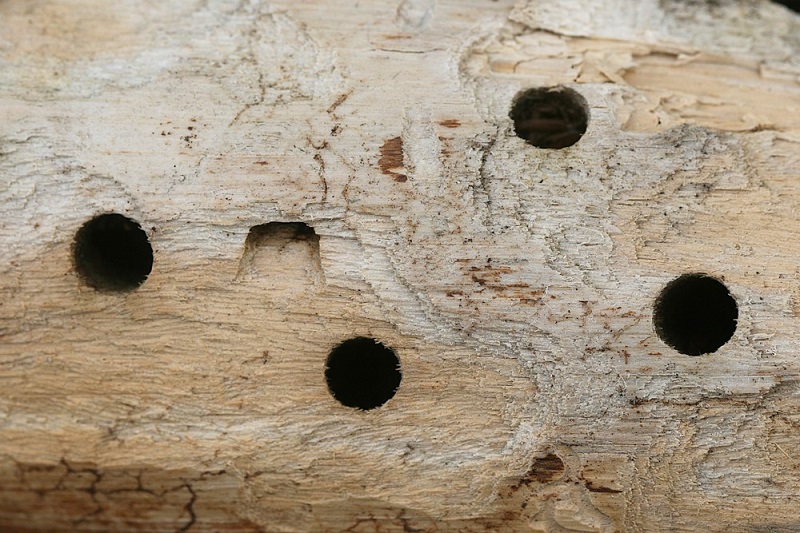
Carpenter bees bore holes in wooden structures like trees, decks, and home sidings. Carpenter-bee infestation indicates smooth holes and sawdust that you can find in the wooden structures around your home. Pest control service providers usually find them under wooden patios, railings, and exposed wooden bases of ceilings.
Carpenter bees prefer to stay on the underside of decks and wooden stairs to hide from the rain and extreme weather conditions. During the nesting season around spring and summer, female carpenter bees will start boring holes in the wood to lay their eggs.
Though they are not much of a threat, carpenter bees are not just digging in one go but create tunnels inside thick wood. Their offspring that grow inside the same tunnel can lay their eggs inside the same tunnel by creating another path inside the wood. Carpenter bees do get attached to their holes since they follow the pheromones of other bees.
If left unmanaged, several generations of carpenter bees can weaken and cause damage to the wooden area of your house. The average lifespan of a carpenter bee is one year, but their whole unit can last in your garden for three years, bearing one to two generations each year.
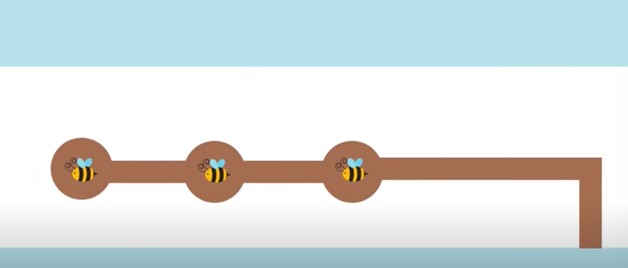
In small units, carpenters are not a threat to your home. Gardeners even let them stay since they benefit from their pollinating skills in the garden. However, for the home improvement savvy, bombarded with these buzzing insects, getting rid of them is the best option.
Do Carpenter Bees Sting?
Now, for the most asked question, do carpenter bees sting? Yes, if provoked. They are usually harmless as long as you don’t touch them. However, they love to hover around as a defense mechanism to protect their nest.
Not all carpenter bees have a sting, some just act like they sting to intimidate other insects that try to get to their nest.
Who’s The Stinging Bee: Female or Male Carpenter Bee?
Female carpenter bees sting while the male looks macho and tough through their hovering defenses. Male carpenter bees usually fly around gardens while their members are busy building their nests.
Due to the behavior of these bees, there’s very little chance for you to get stung. Unless you dig around their hole or intentionally provoke the female bees, you won’t catch a glimpse of the female carpenter bees.
However, if your curious child pokes their fingers in the nest of carpenter bees or you accidentally encounter the female bees, you as a parent must learn how to deal with the sting.
Treatment For Carpenter Bee Sting
The venom from the sting of the carpenter bee is no different than the sting of other bees like honeybees. It can cause inflammation, pain, and even allergy for some people.
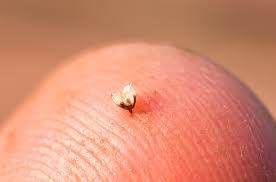
If you don’t have any life-threatening allergic reaction to bee stings like anaphylaxis, there’s nothing to worry about.
Carpenter bee stings can be treated with home remedies and over-the-counter pain relievers. The effect of the sting usually subsides after 24 hours.
To ease the pain, here are some of the steps that you can try:
- Remove the stinger of the carpenter bee using a tweezer. Leaving the sting on your skin will cause more inflammation due to the venom.
- To manage the inflammation due to the sting, place an ice pack to constrict the blood vessels and limit blood flow in the area.
- If the pain is unbearable, you may take some pain relievers.
- You may clean the sting area with water and soap. Do not cover it and let the wound be exposed to the air.
What To Do If you Have an Allergic Reaction To a Carpenter Bee Sting
On rare occasions, people with allergies to bee stings may experience more serious allergic reactions. These include:
- Severe itching in other parts of the body aside from the stung area
- Rashes and hives that spread throughout the body
- Difficulty breathing
- Wheezing
- Nausea
- Diarrhea
- Stomachache
Allergic reactions to a bee sting can happen to anyone, even those who have no previous history of allergy to bees and their sting. So, if you have carpenter bees around your house or property, it’s best to know what to do.
Here are some tips in managing severe allergic reactions to a bee sting:
- Use an epinephrine medication or EpiPen.
- Have a medical professional put you in an Intravenous antihistamine that will act faster than oral allergy medication.
- Keep oxygen ready to help you breathe while waiting for the allergy medication to take effect.
- If the allergic reaction worsens, call a medical professional immediately.
How Do Carpenter Bees Help The Environment?
In recent years, the world is on alert due to the decrease in the bee population across the globe, which threatens their extinction.
In January 2021, a Bloomberg report shared the increasing worries about bee extinction from a study from the One Earth Journal that shows a 25% drop in the recorded species of bees from 2006 to 2015.
Bees are tiny insects that may seem a nuisance at home, but they play an essential role in our ecosystem as pollinators of wild and cultivated plants. Carpenter bees, in particular, do more good than harm.
According to the University of California, they are responsible for:
- Production of seeds that feed both humans, birds, and other wildlife animals.
- Transfer of pollen aids in the cross-pollination of flowers
- Successful fruit and crop production
How Do Carpenter Bees Affect Your House?
The only flaw most homeowners hate about carpenter bees is their damaging effect on wood. They do not create destructive hives like yellowjacket wasps. They are gentle insects but may encourage other pests to damage your home through the holes that they create.
Carpenter bees love unkept or raw and softwood fixtures. They do not eat wood but love digging into it to build their home. If you see carpenter bees lurking around your home, check the following areas where they usually frequent:
Unpainted wood fences
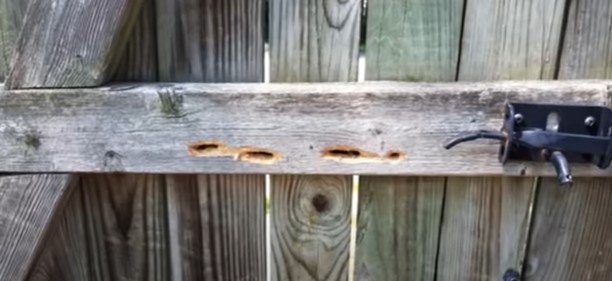
Water-damaged sidings
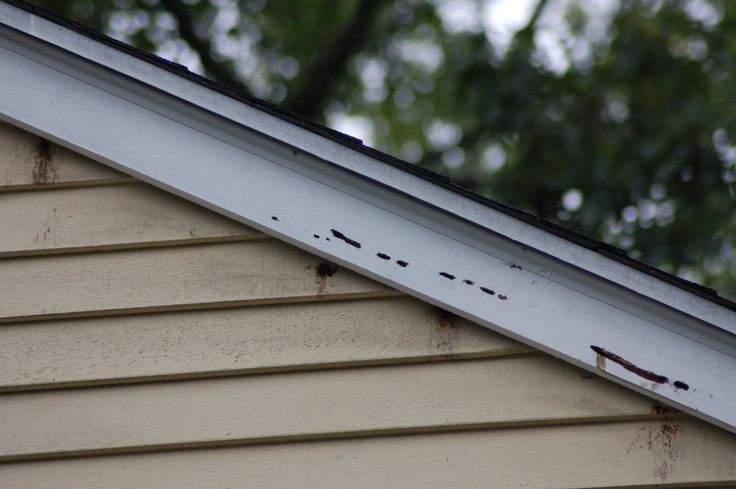
Wooden railings
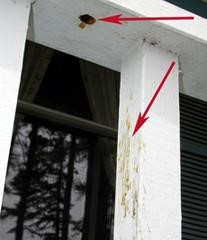
Porches
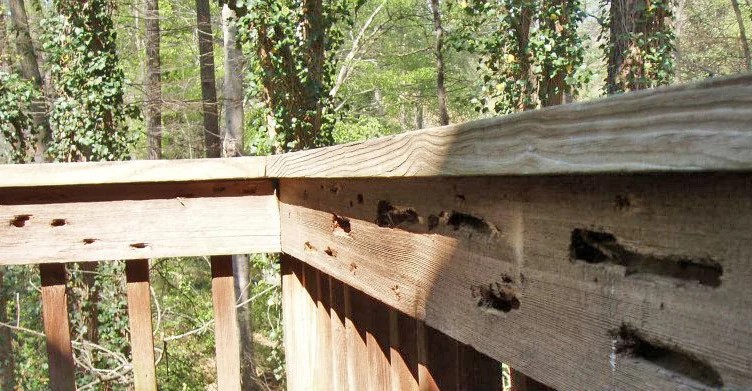
How To Keep Carpenter Bees Away From Your House
Too much carpenter bee population in your property is not ideal for your home. As much as they are welcome as pollinators, compromising the structure of your house would cost you more problems in the future.
Carpenter bees are an asset to the ecosystem but damaging to homes. Due to their good contribution to the environment, killing them would not be the most practical solution. The effects of pesticides are also short-lived and can be expensive due to the frequency of application needed.
Here are some hacks to repel carpenter bees away from your home without killing them:
Place WD-40 in the empty holes, plug, and caulk them
Filling the holes with wood putty and paint will not be enough. Most homeowners find them coming back to the same spot and digging the same hole. They are ruthless when it comes to building their home. So. here’s how you can say goodbye to them forever:
Materials:
- Caulking gun and filler
- Steel wool or aluminum foil
- WD-40
Directions:
- Carpenter bees hate the smell of WD-40. So, soak the holes with WD-40 overnight.
- On the next day, plug the hole with a few steel wool or crumpled aluminum foil.
- Cover the hole using a caulking gun.
Place the hole fillers at the right timing
Aside from keeping the hole impenetrable, doing it at the right time is crucial. Fall is the best time to plug and seal the holes on the wood caused by carpenter bees.
During this season, the eggs hatch, and young carpenter bees are out and about. While they are away, plug the holes, so they will find another spot to stay in for the winter.
Seamlessly coat the plugged holes with paint or wood stain
Keep the bees off your house in the long run and prevent them from coming back by coating the wood or painting it. It is also helpful to fix any water problem in your house that may cause molds and moisture leaks on the sidings and gutter. Water softens the wood, which attracts carpenter bees and even woodpeckers.
Give the bees their designated shelter using bee hotels
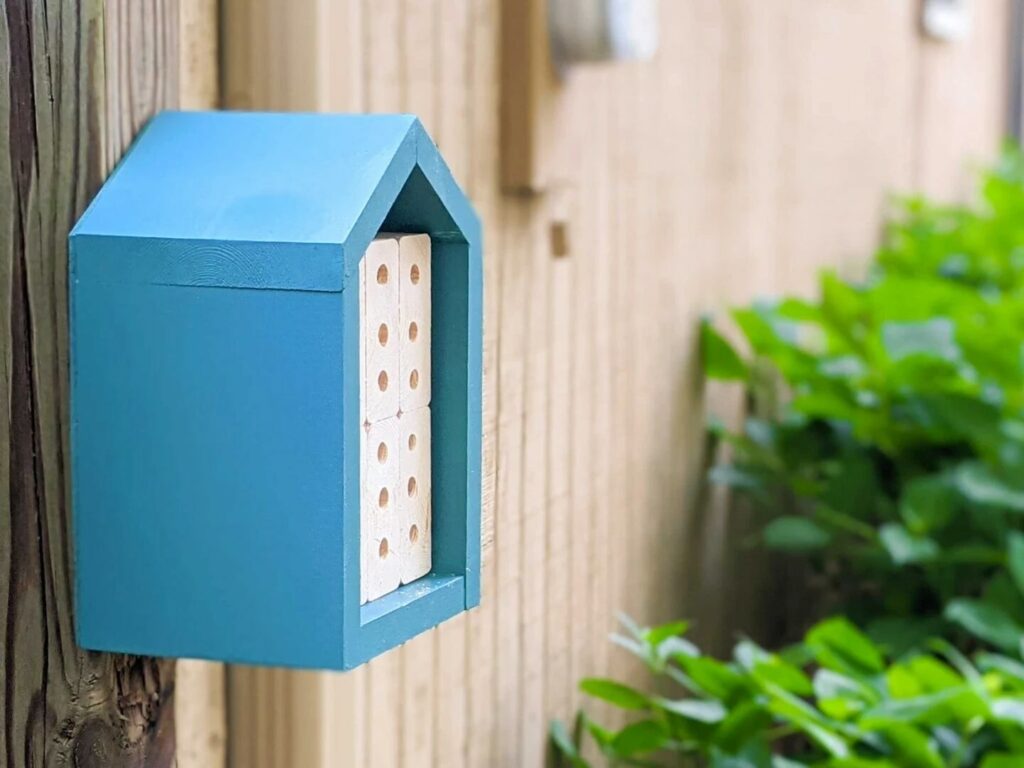
Loving and hating carpenter bees will always put you at crossroads. If you love to have them for your garden but hate to see them in your house, a bee hotel can help. A bee hotel is a pile of small bamboo or wood that you can hang around your garden for them to stay.
One characteristic of carpenter bees is they are lazy and do not move from one nest to another. Once they’re settled in a specific area, they will stay there until they produce several generations of bees.
A DIY bee hotel that you can use is a drilled block of wood placed in a roofed wooden frame. It should be fixed on a tree or a post like a mailbox or a birdhouse. With that, they may opt to stay in the bee hotel rather than damage your porch.
Tips To Prevent Carpenter Bees From Staying in Your House
Home maintenance is crucial to keep carpenters at bay. The holes they make can encourage woodpeckers that will store seeds in every space they can find, like sidings. Termites may also take advantage of the holes and cause more damage to your house. Keep pests at bay by:
- Getting rid of dead tree trunks and decaying woodpiles around your yard
- Filling holes and cracks with wood putty or caulk
- Painting your house every year
- Fixing leaks
- Staining decks and patios
- Painting or staining the underside of your deck
You might also like: What Keeps Sweat Bees Away?: 8 Tips For A Stress-Free Outdoor Experience
Final Thoughts
Carpenter bees may look intimidating or scary since they love bumping in your face or hovering around. They are harmless and very gentle to have around your garden since they do not sting unless provoked. We hope that this post helped you learn more about these chunky pollinators in your garden.
To preserve and prevent the extinction of bees, we highly encourage our fellow gardeners and green thumbs to refrain from using pesticides or killing bees to control them.
They can be annoying, especially when their population in an area increases, and killing them could make sense. However, there are still some bee-friendly ways to keep them off your house.
Let us know in the comments which bee control method worked best for you. Also, please don’t forget to share this post with your friends to help spread awareness about the impact of killing bees n our environment.
